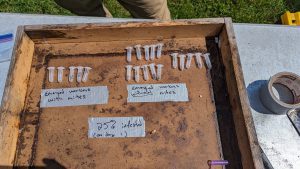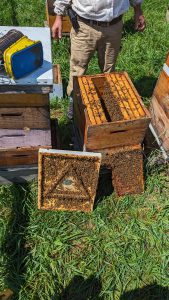By: Zachary Lamas
Varroa largely feed on developing drone brood and on adult bees when drones are seasonally plentiful inside of a honey bee colony. However, when drone productions slows or altogether ceases after the main flow, Varroa shift dramatically onto worker bees. This happens midsummer, just as beekeepers take time away from their colonies. Unfortunately, this is not a lull. Yes, the honey flow is largely over. There is no pressing need for swarm control or to super colonies. The lack of urgency during this time may confer a sense of calm, and that everything is alright, but unfortunately mites have something else in mind.
Migrating into the worker brood
Varroa prefer drone brood over worker brood. This has fact has been established for decades. And when the queen is copiously laying unfertilized drone eggs, drone brood will be plentiful in your colonies. Unless if an infestation is already very high, during this time mites will overwhelming be found right there in your drone brood. During this time, adult drones, a small portion of the total population in your colony, will also harbor most of the mites during their non-reproductive phase. The majority of feedings, and subsequently vectoring of viruses, fall upon the drone cohort, not the worker bees.
This suddenly changes during the mid-Summer, when Varroa shift from the now disappearing drone bees onto the worker cohort. The exact timing will depend on geographic location, colony strength, nectar flow and weather. However, the implications on colony health will be impactful because all of the feedings now flood onto the worker bee population, and these bees, unlike drones, are integral to all in-colony tasks. They rear the brood, they take care of the queen, and they are likely to cause secondary cases of disease transmission through their constant engagement in trophallaxis with nestmates.
But what do these early infestations into worker bees look like? This next part may surprise you. They don’t look like much of anything at all. For a period of time these infestations will appear as asymptomatic infestations. The most nefarious thing Varroa do is heavily feed on the worker bee population, but the damage is not seen for weeks later. By the time you can visually see disease it is too late. At best the colony will be heavily impacted. However, the intense parasitism and circulation of viruses began during the asymptomatic infestation period.

What does asymptomatic infestation look like?
These are colonies which harbor mite populations but are not showing signs of disease. Simply put, these colonies look “healthy”. Here lies some real risk to the beekeeper. Many beekeepers now make splits and late season nucleus colonies. However, beekeepers are artificially dispersing colonies when they make new daughter colonies from these asymptomatic but infested parent colonies. When we do this, we are literally doing the Varroa a favor because we are dispersing the parasite into new host colonies. Worse, when these colonies have issues later in the season, many beekeepers, especially small scale beekeepers, will remove resources from stronger colonies in an attempt to keep them alive. Why is this good for Varroa? We are artificially keeping a host they are reliant upon alive. From the parasites perspective, we are doing it a huge favor. Additionally, by splitting infested colonies we have increased the density of infested colonies within our apiaries.
What can we learn from sampling newly emerged worker bees?
As of now the alcohol wash is the standard method uses to describe Varroa infestations in honey bee colonies. The alcohol wash is not always accurate and beekeepers have become desensitized to alcohol wash results, often ignoring results which show a growing infestation. To portray mite infestation to beekeepers I will collect newly emerged worker bees and separate those bees into two groups: those which emerged with a mite, and those which emerged without a mite. I then quickly calculate the percentage of new workers which on day one of their adult life are starting out with a mite. Why do I do this? Because the results are impactful, and tell a clearer story of what is happening inside of our colony.
The minority of parasitism happens on workers during their brood development. A minority. Most Varroa feedings happen on adult bees. So when we see a picture as seen here, we have to stop and understand a majority of the parasitism invisibly happens. Without intervention this colony’s health will decline, if not perish altogether. Worse, this colony is infectious to neighboring colonies which can acquire these mites through wandering bees or robbing.
 What can we do?
What can we do?
Beekeepers have been divided into factions for way too long based upon underlying beliefs over how to manage mites while simultaneously holding beliefs over long-term adaptation of their bees. In short, are you treatment free or do you treat?
We have held these beliefs while not understanding entirely the biology of Varroa destructor nor the disease ecology of Varroa infestations. Several key facts are coming to light. These mites are extremely mobile within a colony and between colonies. Additionally, these colonies also heavily parasitize a colony before the damage is seen. Given this information, small scale beekeepers can take several actions which will reduce the impact of mites on infested colonies and the healthy colonies surrounding them.
- Identify colonies which are harboring high levels of mites before those colonies become infectious. Manage the mites in these colonies to protect the individual colony, but more importantly to prevent the spread of Varroa into neighboring colonies.
- Requeen colonies which are not suppressing mite reproduction. Good farmers apply selection pressure into their flocks, herds and apiaries. As beekeepers we are obligated to apply this selection pressure. However, given Varroa’s profound mobility, we can not rely upon survival as a metric for mite resistance. Letting colonies collapse and die promotes the dispersal of Varroa, a boon for the parasite.
- Do not split or remove brood from asymptomatic, infested colonies. When we do so we are actually doing a favor for Varroa.
